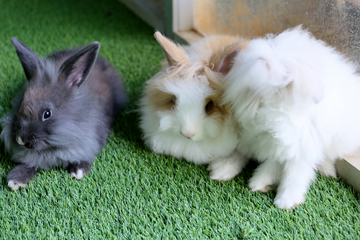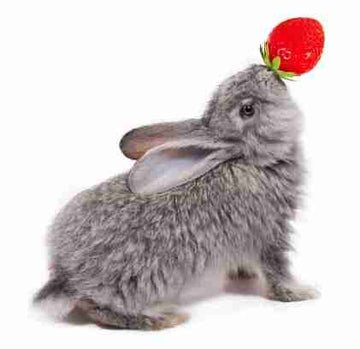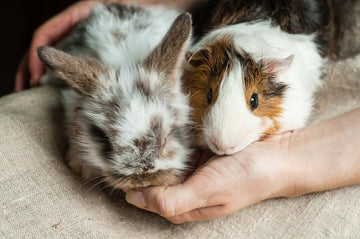Rabbit Play Motivation: Keeping Bunnies Engaged
When your bunny seems disinterested in playtime, it can be confusing and frustrating. You've bought the toys, created the space, and maybe even tried to coax them into play with treats—only to get a blank stare or a lazy flop. But here's the truth: rabbits aren't lazy pets. They're intelligent, curious, and social animals that need the right environment and approach to bring out their playful side.
Click Here to Shop Rabbit Products.

Just like people, rabbits have preferences. What one bunny finds irresistible, another might ignore. The key to rabbit play motivation isn't about forcing fun; it's about discovering what excites your rabbit. Let's dig into what could be going wrong—and how to get it right.
Understanding Why Your Rabbit Might Not Be Playing
Before trying to change your rabbit's behavior, take a step back. Is your rabbit really uninterested, or is something else at play?
Rabbits are crepuscular, meaning they're most active during early mornings and late evenings. If you're expecting an energetic bun at noon, they might just be napping. Another common factor is stress. Loud noises, new surroundings, or unfamiliar smells can make rabbits hesitant to come out and explore. And, of course, health matters—lethargy could be a sign of discomfort, so always consult your vet if you're unsure.
Activities That Tap Into Natural Bunny Behavior
Rabbits love to dig, chew, toss, and explore. So why not set up play options that speak their language?

Bunny Bowling is a favorite among rabbit lovers. Stack lightweight toy pins in a small space and let your rabbit knock them over. Simple? Yes. But rabbits love the cause-and-effect thrill of seeing their mischief pay off. You can even grab a few safe bunny toys designed specifically for rolling and tossing.
Try rotating activities if you're up for building a DIY play zone. A digging box filled with shredded paper or hay lets them dig to their heart's content. Or build a cardboard fort with multiple levels and hiding spots. You might be amazed how much play comes from what looks like trash.
Toys That Inspire Rabbit Play Motivation
It's easy to buy a bunch of rabbit toys online—but will your bunny use them? That depends on their personality. Some like to chew, some prefer to chase, others want to figure things out.
Try a variety of textures and designs. Some great choices include:
-
Edible Timothy Hay balls that satisfy chewing urges.
-
Bird toys that hang or jingle—small enough for your rabbit to toss around with their mouth.
-
Treat puzzles or food balls that dispense snacks as your rabbit rolls them.
If your rabbit isn't showing interest right away, try mixing food with play. Tuck treats into cat puzzle balls, or weave hay into homemade bundles for them to chew and pull apart. When movement = reward, you'll see the motivation build.
DIY Toys and Cheap Enrichment Ideas
You don't need a big budget to entertain your rabbit. Some of the most exciting toys are made with things you already have.
-
Stuff a cardboard toilet paper roll with hay, herbs, or a few pellets.
-
Create a tunnel system with cardboard boxes and tubes taped together.
-
Cut holes in a box to make a mini fort or maze.
-
Braid strands of hay into chewable ropes.
Try rotating toys every week so your bunny doesn't get bored. New smells and shapes are a great way to renew interest without buying anything new.

Creating Spaces That Spark Rabbit Play Motivation
The space your rabbit plays in matters more than you think. Even the best toy will be ignored if your bunny doesn't feel secure.
Make sure your rabbit has access to a spacious, bunny-safe area where they can stretch their legs, binky, and explore. A room that's too open may make them feel exposed. Try using playpens or x-pens to section off a more manageable space filled with hiding spots and tunnels.
If you're playing outside, watch for hazards like predators, toxic plants, or overheating. Supervised play in a screened porch or secured exercise pen is a great way to let them enjoy fresh air safely.
Rabbits Aren't Passive—They're Just Selective
There's a common myth that rabbits are passive, low-effort pets. That couldn't be further from the truth. They crave stimulation and interaction, but it must be on their terms.
In the wild, rabbits live in social groups and constantly explore. That instinct is still strong in our domestic buns. The trick is creating opportunities that respect their personality and schedule.
According to the House Rabbit Society, rabbits show affection and interest in ways that may not look like typical pet behavior. Nuzzling, circling your feet, and even light nibbles are part of how they connect. So if your rabbit isn't chasing a toy but follows you around the room, that's still play to them.
Rabbit Play Motivation Starts with the Right Timing
If you're trying to get your rabbit to play in the middle of the day, you might interrupt nap time. Rabbits are most active at dawn and dusk.
Plan your play sessions around these times. Open their pen, sit quietly on the floor, and wait. Don't force them. If they hop over, give them a light pet and let the session evolve. Give them their space if they're grooming, sleeping, or using the litter box. Let them lead the interaction—it builds trust faster than anything else.
Bonding Through Play and Presence
One of the best parts of rabbit playtime isn't just the fun—it's the connection. Getting down to your rabbit's level, observing their preferences, and gently inviting them to interact creates a stronger bond.
Don't underestimate the value of quiet presence. Just sitting with your rabbit while they explore can make a difference. Over time, they'll associate you with comfort, curiosity, and play. And that's where the real motivation begins.
If your rabbit still seems unsure about playing, look at their environment and enrichment schedule. Rotate toys, tweak the timing, and introduce new scents or textures. The change doesn't need to be huge to be effective. What seems small to us can be exciting to a rabbit.

Building a Happy and Playful Life for Your Rabbit
Creating a play-rich environment is about more than just toys—it's about routine, trust, and understanding your rabbit's instincts. Whether your rabbit is outgoing or shy, there are always ways to build in more fun and activity.
And if you're looking to get your bun more comfortable and playful, our 8 Rabbit Care Tips for Setting Up A Rabbit's Cage is packed with ideas that support healthy play and movement.
Key Takeaways for Better Rabbit Play Motivation
-
Rabbits are naturally curious and active—when they're not playing, it's often due to timing, stress, or lack of stimulation.
-
Rotate toys, include treat puzzles, and use playtime to deepen your bond—not just burn off energy.
-
Morning and evening are the best times for play, and the space matters just as much as the toys.

Fun and Unique Names for Rabbits

Healthy Rabbit Treats for Hoppy Pets








![RHDV2 Critical Information + Frequently Asked Questions [Updated 03/20/2025]](http://www.rabbitholehay.com/cdn/shop/articles/rhdv2-critical-information-frequently-asked-questions-V1.png?v=1742490107&width=360)

